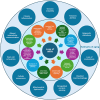An overview of RecQ helicases and related diseases
- PMID: 40728512
- PMCID: PMC12339026
- DOI: 10.18632/aging.206291
An overview of RecQ helicases and related diseases
Abstract
RecQ helicases are known as "caretakers" of the genome for their conserved helicase activities to resolve different complex DNA structures. Aberrant accumulation of unsolved DNA structures could lead to defects in DNA replication, gene transcription, and unrepaired DNA lesions. Pathogenic mutations on BLM, WRN, and RECQL4 are associated with several pathological conditions, namely Bloom syndrome (BS), Werner syndrome (WS), and Rothmund-Thomson syndrome (RTS). These syndromes are characterized by genomic instability and cancer predisposition. Additionally, some RecQ helicase diseases are linked to developmental defects and premature aging. In this review, we provide an overview of the RecQ helicases, focusing on the molecular functions and mechanisms, as well as the consequences of their dysfunction in cellular processes. We also discuss the significance of RecQ helicases in preventing various genetic disorders (BS, WS, RTS) and the insights obtained from the different animal models developed for studying the pathophysiology of RecQ helicase deficiencies.
Keywords: DNA repair; RecQ helicase; accelerated aging; cellular senescence; maintenance of genome stability.
Conflict of interest statement
Figures


Similar articles
-
Human RecQL4 helicase plays multifaceted roles in the genomic stability of normal and cancer cells.Cancer Lett. 2018 Jan 28;413:1-10. doi: 10.1016/j.canlet.2017.10.021. Epub 2017 Nov 7. Cancer Lett. 2018. PMID: 29080750 Review.
-
Human RECQ helicases: roles in DNA metabolism, mutagenesis and cancer biology.Semin Cancer Biol. 2010 Oct;20(5):329-39. doi: 10.1016/j.semcancer.2010.10.002. Epub 2010 Oct 8. Semin Cancer Biol. 2010. PMID: 20934517 Free PMC article. Review.
-
Bloom's syndrome: Why not premature aging?: A comparison of the BLM and WRN helicases.Ageing Res Rev. 2017 Jan;33:36-51. doi: 10.1016/j.arr.2016.05.010. Epub 2016 May 26. Ageing Res Rev. 2017. PMID: 27238185 Free PMC article. Review.
-
Human RecQL4 as a Novel Molecular Target for Cancer Therapy.Cytogenet Genome Res. 2021;161(6-7):305-327. doi: 10.1159/000516568. Epub 2021 Sep 2. Cytogenet Genome Res. 2021. PMID: 34474412 Review.
-
RECQ DNA Helicases and Osteosarcoma.Adv Exp Med Biol. 2020;1258:37-54. doi: 10.1007/978-3-030-43085-6_3. Adv Exp Med Biol. 2020. PMID: 32767233 Review.
References
-
- Puranam KL, Blackshear PJ. Cloning and characterization of RECQL, a potential human homologue of the Escherichia coli DNA helicase RecQ. J Biol Chem. 1994; 269:29838–45. - PubMed
-
- Nakayama H, Nakayama K, Nakayama R, Irino N, Nakayama Y, Hanawalt PC. Isolation and genetic characterization of a thymineless death-resistant mutant of Escherichia coli K12: identification of a new mutation (recQ1) that blocks the RecF recombination pathway. Mol Gen Genet. 1984; 195:474–80. 10.1007/BF00341449 - DOI - PubMed
Publication types
MeSH terms
Substances
LinkOut - more resources
Full Text Sources

